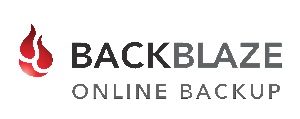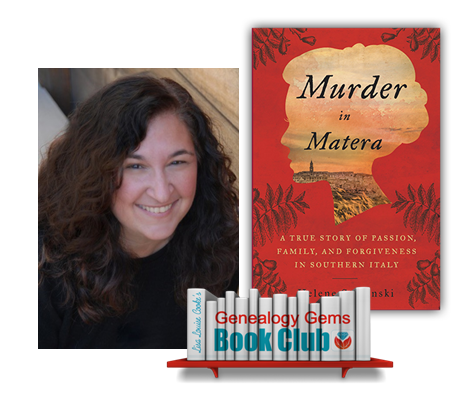Navigating the End of FamilySearch Microfilm Lending
Just announced: The FamilySearch microfilm lending service will end on August 30, 2017. Let’s cover what we know so far, how it may impact you, and strategies for getting the information you need.
WHAT: FamilySearch Microfilm Lending Ends
Most of the Family History Library’s microfilm vault has already been digitized and is online–or will be within a short time. According to the website:
“Over 1.5 million microfilms (ca. 1.5 billion images) have been digitized by FamilySearch, including the most requested collections based on microfilm loan records worldwide.”
However, the world’s largest lender of microfilmed genealogical records will be discontinuing the distribution of microfilms to Family History Centers in the near future.
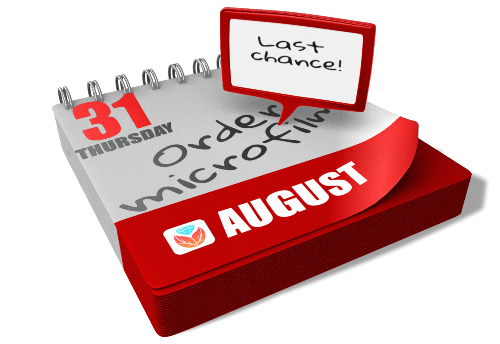 “On September 1, 2017, FamilySearch will discontinue its microfilm distribution services,” announced the site yesterday. “The change is the result of significant progress in FamilySearch’s microfilm digitization efforts and the obsolescence of microfilm technology. Digital imaging has made it easier to find ancestors through the internet, mobile, and other technologies.”
“On September 1, 2017, FamilySearch will discontinue its microfilm distribution services,” announced the site yesterday. “The change is the result of significant progress in FamilySearch’s microfilm digitization efforts and the obsolescence of microfilm technology. Digital imaging has made it easier to find ancestors through the internet, mobile, and other technologies.”
This means the clock is now counting down your ability to borrow microfilmed genealogical records from the Family History Library. The last day you can place an order for delivery to your local Family History Center is August 31, 2017.
It’s a change I’ve seen coming, but it’s still a little disconcerting now that it’s here. But change is the norm in today’s busy world, so let’s break down the details we know so far together.
WHY: Why are they discontinuing microfilm lending before they’re done digitizing?
It’s just too expensive. “The cost of duplicating microfilm for circulation has risen dramatically, while demand has decreased significantly,” says a FamilySearch Q&A. “At the same time, it has become increasingly difficult and costly to maintain the equipment, systems, and processes required for film duplication, distribution, and access.” FamilySearch wants to redirect its microfilm lending resources to providing more and better electronic record access.
I have personally visited the microfilm distribution facility, and the best analogy I can give you is that it looks a bit like the inside of an Amazon warehouse. It’s a mammoth and expensive undertaking, certainly not something you open or close lightly. I’m thankful that in the decades before the Internet, FamilySearch devoted so many resources to helping all of us gain access to hard-to-find records from around the world.
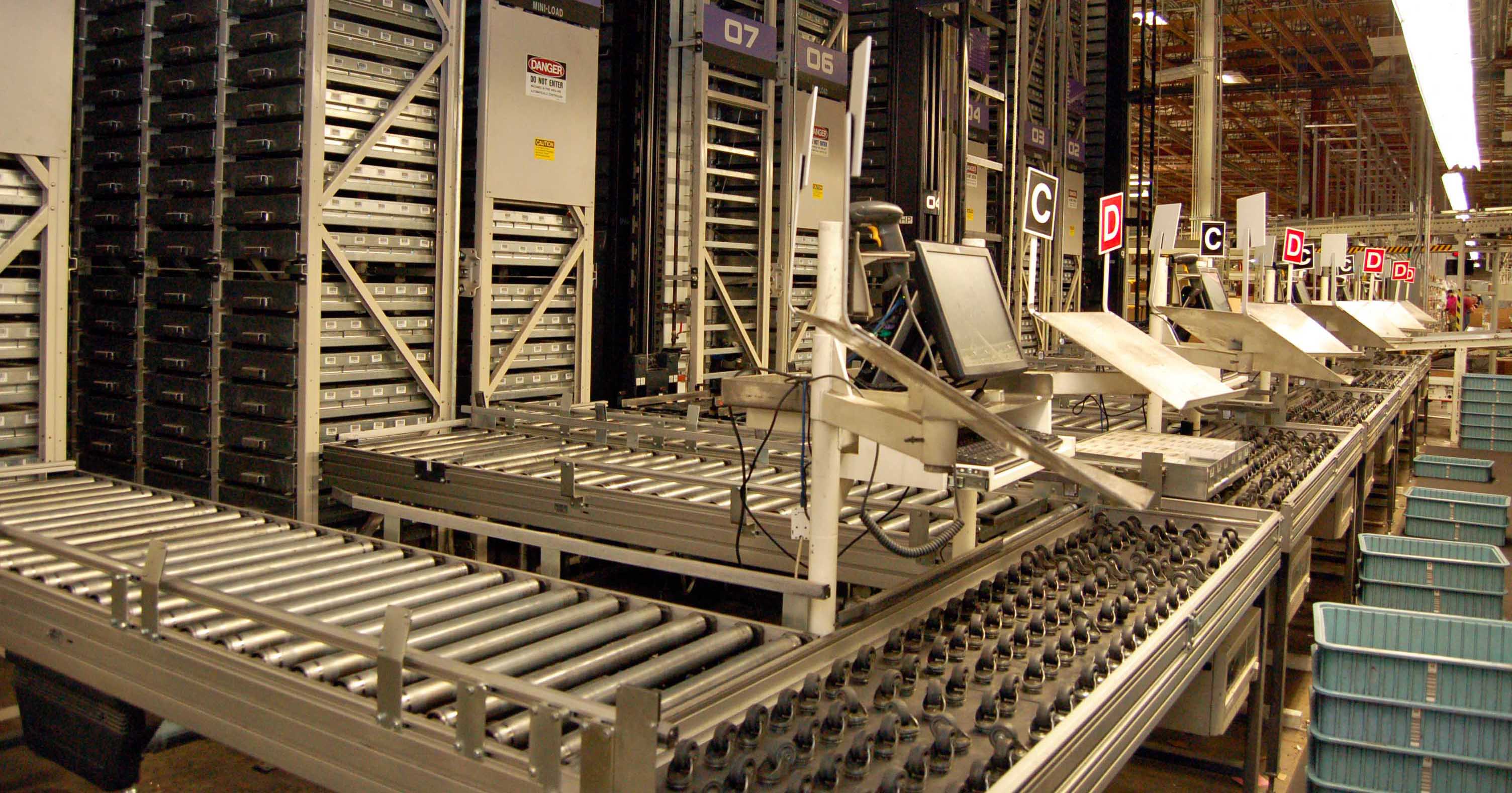
Photo Credit: Lisa Louise Cooke
WHEN: What will be available online and when
According to FamilySearch, they hope to finish digitizing the records that they have permission to digitize, in 2020. Unfortunately, some films we will not be digitized because of contractual limitations, data privacy, or other restrictions. Look to the Catalog for access details for the records you want.
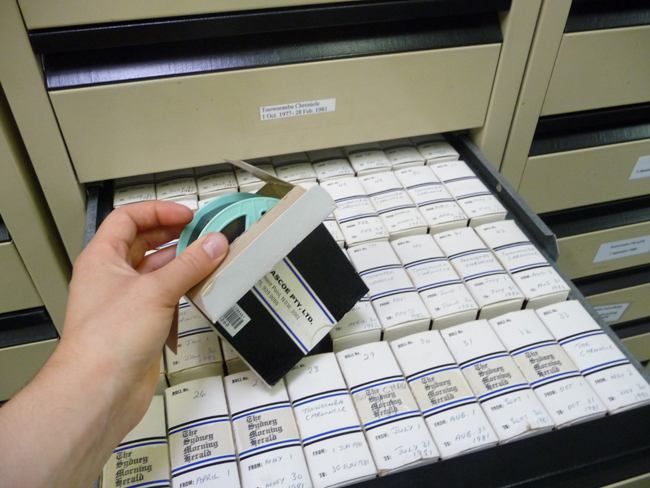
By Lhsunshine (Own work) [CC BY-SA 3.0 (http://creativecommons.org/licenses/by-sa/3.0)], via Wikimedia Commons
HOW: How to order FamilySearch microfilms between now and August 31, 2017
I encourage you to use the microfilm lending service while it is still available. While most microfilmed records will be eventually digitized, the fate of a small percentage may remain unknown for some time. Follow these steps to view them now:
1. Go to FamilySearch.org and log in, or create a free login. (You’ll need the login to order records.)
2. Under the Search menu, select Catalog.
3. Search by location, listing first the largest jurisdiction (such as the country) and proceeding to the smallest, such as “United States, Illinois, Cook, Chicago.”
4. Review search results by clicking on the record categories and then each entry. Within the entries, watch for interesting items that only list microfilm or microfiche formats.
5. Within record entries, order items you want by clicking the microfilm reel icon on the far right, under Format. Select the lending period and the correct currency. It currently costs $7.50 USD to borrow a microfilm reel for 90 days.
During the order process, you’ll select a family history center near you to receive the item(s). When your order arrives, you’ll be notified. Check the center’s schedule before visiting; most have limited hours. Centers are free to use. When you get there, identify yourself and request your film. Then put it in the microfilm reader and scroll through it until you find the item number and pages you need. (Here’s a helpful article: How to Use a Microfilm Reader.)
What about accessing microfilmed records after August 31, 2017?
You’ll still have several options. Sunny Morton, author of the quick reference guide Genealogy Giants: Comparing the 4 Major Websites, says the FamilySearch catalog will still be a go-to resource:
“At this point, the Family History Library in Salt Lake City, Utah still plans to keep on hand microfilmed copies of records that are not yet online. So your options include going to view them in person (since to the best of our knowledge the library won’t be lending them), arrange for someone else to view them (such as through the Random Acts of Genealogical Kindness Facebook group), or use the FamilySearch Catalog to identify the records and then attempt to locate them through other repositories and websites.
To find records you may borrow from other sources, click where it says ‘View this catalog record in WorldCat for other possible copy locations’ [see screenshot below]. This will take you directly to this item’s listings in WorldCat, which is the enormous, free multi-library online catalog. Look either for a copy at a library near you, or a copy at a facility that participates in inter-library loan. (This is the same process you already have to use to find copies of books you can borrow, since the Family History Library doesn’t lend these, either.)”

What about accessing the digitized records?
After August 31, 2017 many genealogists will be turning to the online FamilySearch catalog and Family History Center Portal. (Learn more about the Portal at the FamilySearch Wiki.) As you attempt to view records through the portal, you may be prompted to go to a Family History Center to view the record, and the site will link you to a map of all locations. It’s important to understand the difference between an official Family History Center and an Affiliate Center. We’ve learned that Affiliate Centers do not have access to what is called the Family History Portal. That portal is only accessible from an officially designated Family History Center.
So how do you know which location on the map is official, and which is an affiliate? I turned to genealogy blogger and friend of Genealogy Gems Amie Tennant for clarification:
The (online) FamilySearch map of Family History Centers is not accurate. With the new changes to microfilm loans, this is going to be a big problem. In other words…if a person assumes all FHCenters are the same and travels to the nearest one, they will be sorely disappointed to realize that this one will NOT have access to all the digitized microfilm. (Researchers) should call ahead to confirm whether the center they see on this map is an affiliate or a full FHC with access to the portal.
I’ve reached out to FamilySearch for additional official information on this and several other important questions that have arisen with the discontinuation of microfilm lending. I’ll report to you here on the Genealogy Gems blog and the podcast as more information becomes available. Check out Amie’s article for more information on the various levels of access.
What do you think?
The end of the FamilySearch microfilm lending service is a major milestone. It signals exciting future online access, but provides obstacles for the next few years. What suggestions do you have for researchers to gain additional access to essential microfilm? Please share with the Genealogy Gems community in the Comments below.
Millions of global records now at FamilySearch.org
Millions of records from around the world are new at FamilySearch this week, and are completely free! These new collections include Australia, Denmark, Finland, France, Italy, and South Africa. PERSI also got a big update this week at Findmypast, as well as new and updated records for Canada, England, and Ireland.
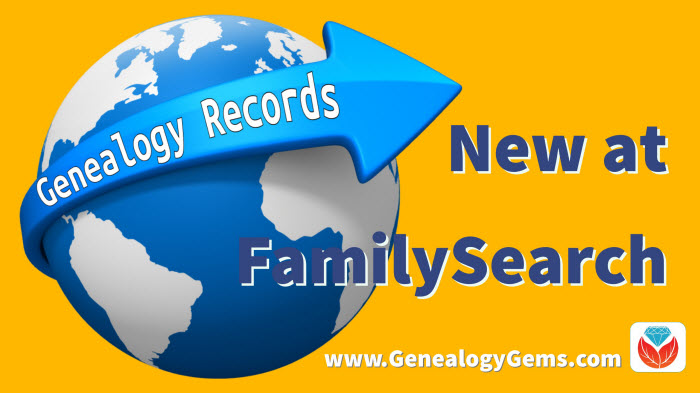
New collections free at FamilySearch
Australia. The new South Australia, Immigrants Ship Papers, 1849-1940 collection includes immigrants’ ships papers, containing a record of births and deaths aboard, 1849-1867 and 1873-1885. Indexed records in this collection include passenger lists arriving and departing from South Australia. (Original records in the State Records of South Australia, Adelaide.) Get started with Australian genealogy research with these tips from an expert at Legacy Tree Genealogists!
Denmark. FamilySearch has been adding census records for Denmark recently, and the latest new collection is the 1921 Denmark Census. This collection includes over 430,000 images, and these census collections were all provided by MyHeritage and previously from the National Archives of Denmark.
Finland. Church Census and Pre-Confirmation Books, 1657-1915: This collection contains church census books and pre-confirmation books kept by the Lutheran Church in Finland. These records come from a database at MyHeritage, citing Kansallisarkisto (National Archives of Finland), Helsinki.
France. Explore over half a million indexed records for Saône-et-Loire, Census, 1856, a complete indexing of the population censuses.
Italy. The Salerno, Civil Registration (State Archive), 1806-1949 collection includes civil registration (stato civile) records of births, marriages, and deaths within the custody of the State Archive of Salerno (Archivio di Stato di Salerno). Almost 6 million images are in this collection, and availability of records is largely dependent on time period and locality.
South Africa. Lastly, this collection of Pietermaritzburg Estate Files 1846-1950 is also new at FamilySearch. Records include death notices, vital records, wills, distribution accounts, and succession duty accounts.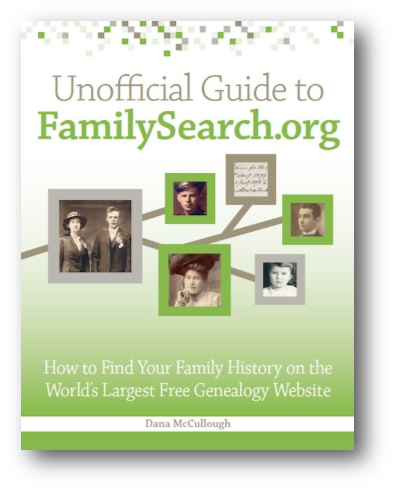
Need help using FamilySearch? The Unofficial Guide to FamilySearch.org by Dana McCullough provides the guidance you need to discover your ancestors and make the most of the free site’s valuable resources. Learn how to maximize all of FamilySearch.org’s research tools–including hard-to-find features–to extend your family tree in America and the old country.
PERSI update at Findmypast
The Periodical Source Index (also known as PERSI) has had another large update at Findmypast. Almost 11,000 new articles and 30,000 new images have been added, covering Pennsylvania, Wyoming, Toronto, and Yorkshire. PERSI is an excellent resource for discovering articles, photos, and other material you probably won’t find using conventional online search methods.
Click here to learn more about PERSI for genealogy research. Genealogy Gems Premium Members can also check out Premium Podcast episode #135 for more tips on PERSI (sign-in required). Not a Premium Member? Click here to get started!
Canada – New & Updated Collections
From Libraries and Archives Canada: Digitization of the Canadian Expeditionary Force Personnel Service Files. “As of today, 502,740 of the 640,000 files are available online in our Personnel Records of the First World War database…Library and Archives Canada is digitizing the service files systematically, from box 1 to box 10686, which roughly corresponds to alphabetical order.”
Ancestry.com updated two of their collections for Canada this week: Ontario, The Ottawa Journal (Birth, Marriage, and Death Notices) 1885-1980 and the Canada Obituary Collection, 1898-2017. Both of these collections come from microfilmed copies of the newspapers.
England Registrations
Recently announced on Twitter: “The General Register Office for England and Wales (GRO) is piloting a service from 12 October 2017 to provide portable document format (PDF) copies of digitized historical birth and death records. The pilot will run for a minimum of 3 months to enable GRO to assess the demand for this service over a prolonged period.” England and Wales records which are available as PDFs in this extended pilot include births (1837 –1916) and deaths (1837 –1957).
Ireland: Historical Newspaper
A new historical newspaper title was added to the British Newspaper Archive this week for Northern Ireland. The Coleraine Chronicle 1844-1910 was published by Alpha Newspaper Group in Coleraine, Londonderry, Northern Ireland. The collection features nearly 3,500 issues and over 26,000 pages.
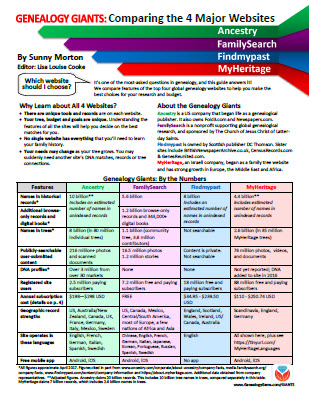 Get the most out of your genealogy records websites subscriptions!
Get the most out of your genealogy records websites subscriptions!
Use the jammed-packed Genealogy Giants cheat sheet by Sunny Morton to quickly and easily compare all of the most important features of the four biggest international genealogy records membership websites: Ancestry.com, FamilySearch.org, Findmypast.com, and MyHeritage.com. Then consult it every time your research budget, needs or goals change. Tables, bulleted lists, and graphics make this guide as easy to use as it is informative. Available in print or digital download.
Disclosure: This post contains affiliate links and Genealogy Gems will be compensated if you make a purchase after clicking on these links (at no additional cost to you). Thank you for supporting the free Genealogy Gems podcast and blog!
Episode 207 – Interview with Mary Tedesco
Genealogy Gems Podcast Episode 207
with Lisa Louise Cooke
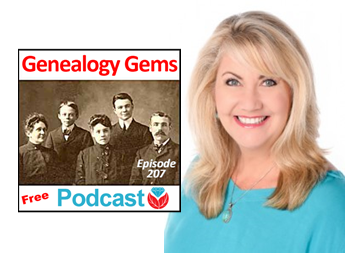
In this episode, Lisa welcomes Mary Tedesco, a co-host of PBS’ Genealogy Roadshow. Mary shares stories and tips about tracing Italian and Italian-American roots. Also:
- FamilySearch updates since the end of microfilm lending (and how YOU helped make the last days of lending more effective);
- A listener uses Google to find her mysterious great-grandmother, with a success story she calls a “game-changer” for her genealogy research.
- The premiere of Military Minutes with Michael Strauss
DOUBLE THE FUN WITH MORE GENEALOGY GEMS PODCAST

This episode launches the NEW twice-monthly Genealogy Gems Podcast format. From now on, watch for two free episodes every month, each about 35-45 minutes long.
If you haven’t downloaded the Genealogy Gems app for easier listening on your mobile device, consider doing so now to make it twice as easy on yourself?and get twice the bonus content from now on!
If you’re listening through the Genealogy Gems app, your bonus content for this episode is?. The Genealogy Gems app is FREE in Google Play and is only $2.99 for Windows, iPhone and iPad users.
FAMILYSEARCH RECORDS ACCESS UPDATE
ALL of the microfilmed records that have been rented in the past 5 years have now been digitized, over 1.5 million films.
From now on, if you need a film that hasn’t been digitized yet, you can call FamilySearch Support toll-free (866-406-1830) and request it for the priority digitization list.
They continue to digitally scan about 1000 films per day. (That sounds like a lot, but at this rate it will still take them until 2020 to be done.)
New digital images are being put in the FamilySearch Catalog as soon as possible. This is not the main digital record search area! It will take collections a while to appear here. Instead, under the Search tab, select Catalog, and then search by place and record type or other categories. This is a master catalog of all the Family History Library’s collections, online and offline, and when you click on an item’s individual description, you’ll be able to see a link to its digitized version if it’s available.
If you or anyone else had any films on loan in family history centers and FamilySearch affiliate libraries when the lending program ended, those automatically have extended loan status, which means they can stay there indefinitely unless the management decides to send them back.
If all else fails, you can still go to the Family History Library in Salt Lake City, UT and order microfilmed records to view, or you can hire someone to do it for you.
FamilySearch Affiliate libraries now have access to nearly all of the restricted image collections as family history centers.
Click here to read or listen to Lisa’s special interview with Diane Loosle of FamilySearch. It goes into much more detail about accessing records on the site, at affiliate libraries and more.
Click here to read the August 30, 2017 update from FamilySearch.
To save 30% off a Care.com Premium membership, visit care.com/gems when you subscribe.
I had so much fun opening the box. They even sent me an apron!
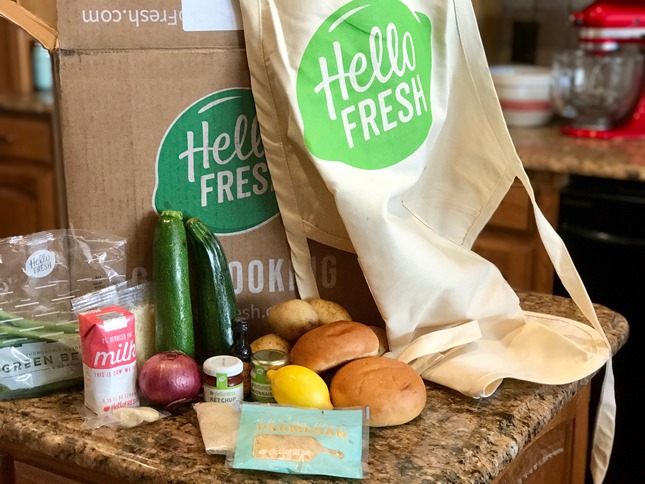
Visit hellofresh.com and use promo code gems30 to save $30 off your first week of deliveries.
NEWS: FREE GENEALOGY WEBINAR FROM NYC
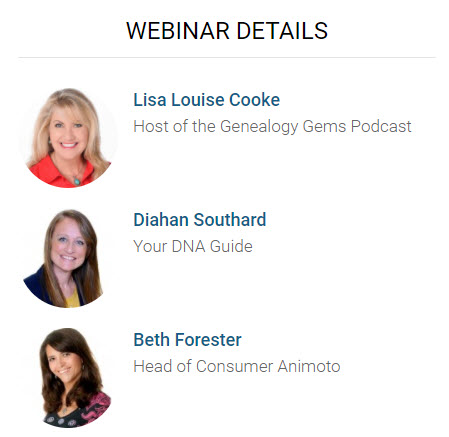
Lisa Louise Cooke’s Genealogy Gems presents:
Reveal Your Unique Story through DNA & Family History sponsored by Animoto
Saturday, September 23, 2017 11:00 AM EST
- Turn DNA results into your family history
- Turn your family history into a compelling story
- Turn your compelling story into a video!
Learn from Lisa Louise Cooke, Diahan Southard and Animoto’s Beth Forester:
- Your DNA testing options (there are more than you think), and possible outcomes
- The best free resources for going beyond DNA, back several generations in your family (quickly!)
- Creative ideas for filling in the story gaps
- How to expand your story in ways you never expected by finding DNA connections
- Share the story you’ve uncovered with the world through riveting video
Lisa chat with Hannah about Hurricane Harvey
Keep your family history research, photos, tree software files, videos and all other computer files safely backed up with Backblaze, the official cloud-based computer backup system for Lisa Louise Cooke’s Genealogy Gems. Learn more at http://www.backblaze.com/Lisa.
MAILBOX: KRISTIN’S SUCCESS STORY
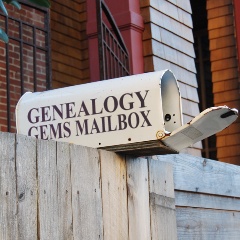

“Among the handful of mystery photographs of my grandmother as a child and the strangers who sat beside her, was a brief article from a newspaper. It was a lesson in manners, titled ‘Silence is Golden’ and it was written by Merton Markert, a student of the Modern Classics. A photo of a young woman with a disheveled Gibson hairdo was attached.”
The Genealogist’s Google Toolbox by Lisa Louise Cooke teaches the search strategies you need to do searches like these.
Try Ebay! Lisa found a listing for a commencement program from 1902, old post cards of the school, and other yearbooks from Lancaster High School. Sign up for a free Ebay account, run a search, and then click to Follow the search. You will then be alerted to future auctions that match your criteria.
Click here for tips on finding yearbooks and other school records.
Genealogy Gems Premium member perk: Premium Podcast episode 16 has great tips for using Ebay to find family history treasures. Click here to learn more about Premium membership.

INTERVIEW: MARY TEDESCO of Genealogy Roadshow
MARY M. Tedesco is a professional genealogist, speaker, and author. She is a host and genealogist on PBS’ Genealogy Roadshow” and Founder of ORIGINS ITALY. Mary speaks fluent Italian and travels often to Italy to conduct client genealogical research and visit family. She is co-author of Tracing Your Italian Ancestors.

Click here to watch a free interview with Mary Tedesco with more tips on doing Italian genealogy research.
GENEALOGY GEMS BOOK CLUB
Murder in Matera by Helene Stapinski tells the story of the author’s journey to Italy to learn the truth behind the family stories about her Italian ancestors. Tune in to Genealogy Gems Podcast episode 208 later this month to hear an excerpt from a conversation with Helene Stapinski. (The entire interview will play in Genealogy Gems Premium Podcast episode 151.)
MILITARY MINUTES: DRAFT REGISTRATIONS
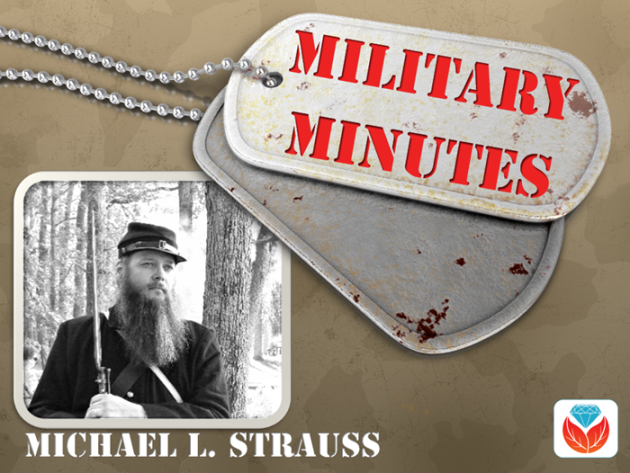
INTRODUCING MICHAEL STRAUSS
Michael Strauss, AG is the principal owner of Genealogy Research Network and an Accredited Genealogist since 1995. He is a native of Pennsylvania and a resident of Utah and has been an avid genealogist for more than 30 years. Strauss holds a BA in History and is a United States Coast Guard veteran.
BONUS handout to celebrate this new segment: Click here for a 4-page handout on U.S. draft registration records by Michael L. Strauss.
FREE GENEALOGY NEWSLETTER:
Subscribe to the Genealogy Gems newsletter to receive a free weekly e-mail newsletter, with tips, inspiration and money-saving deals.


